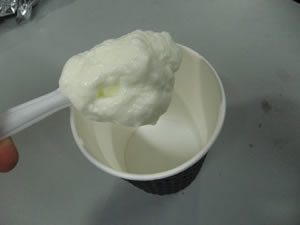Bacteria
Food production (Yoghurt)

1 litre of milk
Paper cups
Natural yoghurt
Cling Wrap
Spoon

Place a scoop of yoghurt in the cup. This contains the bacteria, lactobacillus acidophilus, needed to ferment the lactose in the milk and form yoghurt.
Enzymes within the bacteria convert lactose into lactic acid and further breakdown results in glucose and galactose formation.

Heat the milk slowly to 85 oC and keep it at this temperature for 2 minutes. Cool the milk to 40 oC slowly over a period of 15 minutes.
Fill the cup with the milk and stir.
Cover the cup with Cling Wrap and place in an oven at 40 oC until the mixture thickens. This should take 3 -6 hours.

Yoghurt involves the fermentation of milk at warm temperatures by bacterial cultures.. made with a variety of ingredients including milk, sugars, stabilizers, fruits and flavors, and a bacterial culture. Sugar, fruit and chemicals, known as stabilisers, are later added to give the yoghurt extra flavour.
Ordinary milk can not be used as a raw material for the making of yoghurt. It must first be reduced in fat content by centrifugation and the concentration of casein and other proteins is further increased by allowing water to evaporate from the milk. The milk is then pasteurised to destyroy any micro-organism that may interfere with the fermentation process.
During the fermentation process the level of lactic acid is monitored. At lactic acid levels of 1% the fermentation process is stopped by rapid cooling. Too long or too short a fermentation will produce a product that is inferior in either flavour texture.
Compare the texture, taste and price of your "homemade" yoghurt to commercial brands.
What is a centrifuge?
How does it separate mixtures such as milk into its different constituents?
What is pasteurisation?
Why does cooling stop the fermentation process?
Yoghurt originated in the Balkans and the Middle East; it is now quite popular in Europe and America, as well. The microorganisms used in the production of yogurt accomplish two tasks: production of lactic acid and flavor components. The secret to tasty yogurt is in the proper control of the temperature at various stages. If the temperature is too low, the culture grows too slowly to adequately acidify milk and to achieve a good texture. The commercial starter is a mixed culture of thermophilus and L. bulgaricus. The culture is killed if the temperature is too high. In addition, there is a subtle difference in the taste because the formation and secretion of metabolites which contribute to the overall taste are dependent on the growth rate. The window of proper fermentation is quite small, i.e. from 42 ºC to 44 ºC. In general, as the temperature is raised up to 44 ºC, the rate of culture metabolism is higher, and the yogurt is sweeter. Faster growth also prompts the yogurt to set faster. When the desired acidity is reached, yogurt is quickly cooled to halt further fermentation and metabolic activity. This cooling step is quite critical in industrial yogurt production; it must be done quickly to control tightly the acidity of the yogurt, which has a profound effect on the taste.